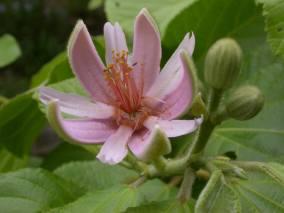Grewia lasiocarpa
Grewia lasiocarpa E.Mey. ex Harv.
Family: Malvaceae
Common names: forest raisin (Eng.); bosrosyntjie (Afr.); umhlolo (Xhosa); ilalanyathi (Zulu)
SA Tree No: 461
Introduction
Grewia lasiocarpa is a wonderful fast-growing small tree, ideal for use as a screen, with lovely large, star-shaped pink flowers and fruit that is attractive to birds.

Description
Description
Grewia lasiocarpa is a fast-growing, large evergreen shrub or small tree, 3-5 m tall and as wide, which can scramble if given the opportunity. Bark is smooth and grey. The foliage is dense with leaves that are large, almost circular, rough-haired above and densely covered with soft hairs below. Attractive, large, pale pink flowers occur from January to March (summer) followed by 4-lobed furry reddish fruit from May to July (autumn) which may often remain on the tree for long periods, eventually turning black.

Distribution and habitat
Distribution description
The forest raisin is widespread in KwaZulu-Natal and the Eastern Cape, naturally occurring on the forest margins, at an altitude range of 5 to 1220 m. It is easy to grow and will tolerate most climates, but does best in areas of high rainfall, and is also frost tolerant.

Derivation of name and historical aspects
History
Grewia is named after Nehemiah Grew (1641-1712), an English physician; lasiocarpa means shaggy fruit.
This plant resembles Trimeria grandiflora when not in flower, which has leaves with 5-7 distinct veins at the base, whereas G. lasiocarpa has only 3 distinct veins.
Other noteworthy members of this genus are G. occidentalis, G. hispida, G. hexamita, and G. flavescens. Grewia has more than 400 species widely distributed in Africa, Asia and Australia with 27 of those species naturally occurring in southern Africa.
Ecology
Ecology
Grewia fruit is very attractive to birds and wild animals such as warthogs and baboons. Seeds that have passed through these animals germinate readily, because the seeds' natural chemical inhibitors are broken down by the animals' stomach acids.

Growing Grewia lasiocarpa
Grow
A decorative addition to any garden, the forest raisin prefers full sun but will tolerate some light shade. It is not fussy about soil and is drought-hardy once established. Compost regularly to support its fast growth rate. Prune only to shape lightly if necessary.
Use in a mixed background planting, as a dense screen, or as informal hedging.
It grows easily from seed, the best results being achieved when sown fresh; sow in spring or as soon as collected (fruiting occurs May to July). Remove seed from the capsule and sow in a sandy loam soil mix in a seed tray. Keep the tray moist in a warm place. Germination should take 4 to 6 weeks. Propagation will also be successful from semi-hardwood cuttings taken in spring. Treat with a root-stimulating hormone powder. Place cuttings in any well-drained rooting medium and kept moist for three to six weeks. Rooted cuttings can be planted in nursery bags in a well-drained growth medium. Plants will benefit from regular fertilising.
References
- Johnson, D. & Johnson, S. 1993. Gardening with indigenous trees and shrubs. Southern Book Publishers, Halfway House.
- Leistner, O.A. (ed.). 2000. Seeds plants of southern Africa : families and genera. Strelitzia 10. National Botanical Institute, Pretoria.
- Pooley, E. 1993. Trees of Natal, Zululand and Transkei. Natal Flora Publications Trust, Durban.
- Thomas, V. & Grant, R. 2000. Sappi tree spotting-Highveld. Jacana Education, Johannesburg.
- Van Wyk, A. (Braam) & Van Wyk, P. 1997. Field guide to trees of southern Africa. Struik, Cape Town.
- Heywood,V. H., Brummitt, R.K., Culham, M.A. & Seberg, RG, O. 2007. Flowering plant families of the world. Firefly books Ltd, Ontario,Canada.
Credits
Cherise Viljoen
Kirstenbosch
June 2007
Plant Attributes:
Plant Type: Shrub, Tree
SA Distribution: Eastern Cape, KwaZulu-Natal
Soil type: Sandy, Clay, Loam
Flowering season: Late Summer, Autumn
PH: Neutral
Flower colour: Pink
Aspect: Full Sun, Afternoon Sun (Semi Shade)
Gardening skill: Easy
Special Features:
Horticultural zones











Rate this article
Article well written and informative
Rate this plant
Is this an interesting plant?
Login to add your Comment
Back to topNot registered yet? Click here to register.